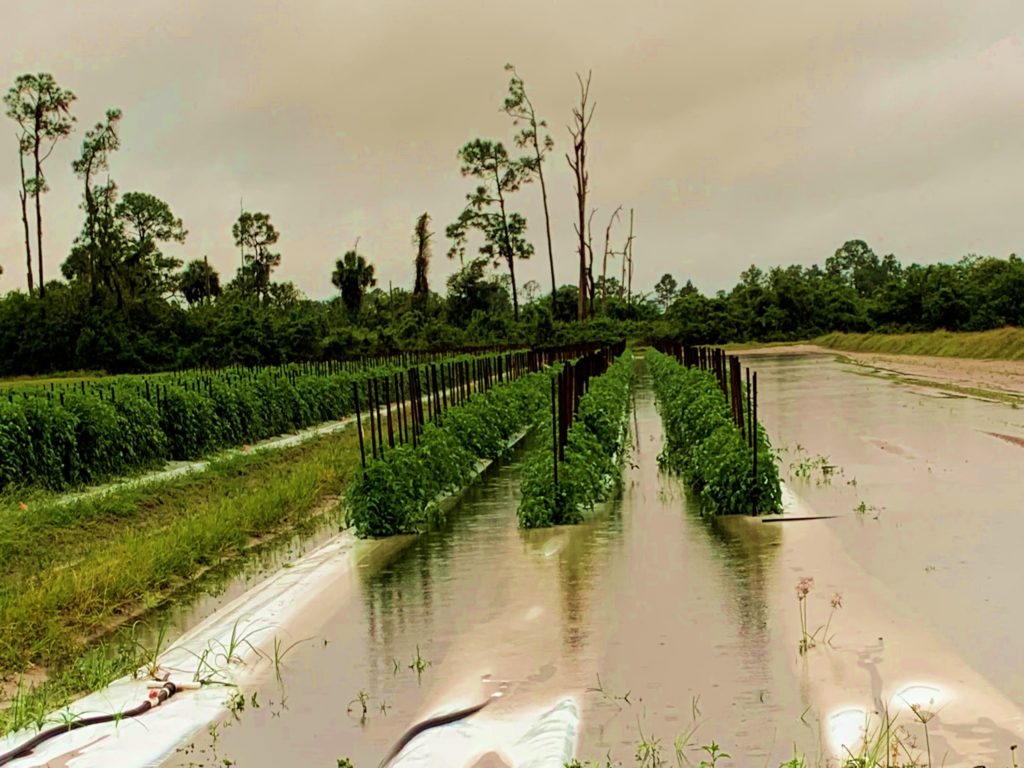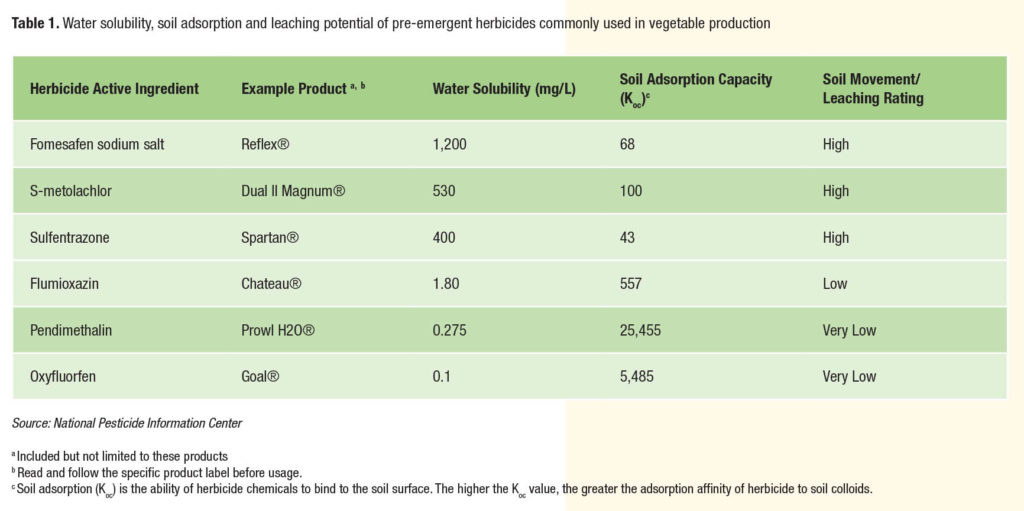By Ruby Tiwari, Nirmal Timilsina and Ramdas Kanissery
Heavy rainfall received in vegetable-growing regions of Florida frequently creates standing water in fields (Figure 1). These farms are often in an early or mid-growing season during such severe weather events. Pre-emergent (residual) herbicides that are integral to vegetable production to suppress weed emergence are applied during this period.
Most pre-emergent herbicides need sufficient water for activation. Hence, rainfall (for instance, less than 1 inch) is often helpful in turning herbicide into a form that can be readily taken up by the weed seeds or emerging weed seedlings. However, an enormous amount of rainfall and consequent flooding may adversely impact the efficacy of pre-emergent herbicides. Therefore, it is crucial to understand how excessive rain and flooding could affect the weed control effectiveness of these herbicides and how it is influenced by the soil and the herbicide’s properties.

Photo by Jessie Watson
SOIL PROPERTIES
Pre-emergent herbicides are designed to stay in the top layer of the soil to suppress weed emergence. However, soil texture, soil type and organic matter content can affect pre-emergent herbicide efficacy and determine its behavior during flooding.
Generally, vegetable production soils in Florida are sandy, coarse-textured, have very low organic matter content and a low cation exchange capacity. Consequently, this soil type typically lacks binding sites for herbicides. Hence, many pre-emergent herbicides utilized in Florida vegetable production are more prone to leaching (downward movement) from topsoil and losing weed suppression efficacy under heavy rainfall due to shorter presence within the soil profile. On the contrary, there are potential carryover issues when herbicides are more tightly bound to the soil. So, it is worthwhile to pay attention to the herbicide labels before application for information on the variable rates recommended for the specific soil texture and organic matter content.
HERBICIDE PROPERTIES
The behavior of pre-emergent herbicides in the soil during rainfall and flooding events is also affected by physiochemical properties of herbicides like water solubility and soil adsorption capacity.
The water solubility of the herbicide largely determines its leaching potential after rainfall. Leaching occurs when the herbicide is dissolved in water and moves down through the soil profile. Herbicides that readily leach due to heavy rain may be carried away from weed germination zones, resulting in reduced efficacy. For instance, S-metolachlor, a widely used herbicide in vegetable crops to suppress the emergence of sedges and broadleaved weeds, is relatively highly soluble in water. It dissipates relatively more quickly from the coarse-textured (such as sandy) soils under heavy rainfall.
Soil adsorption capacity (indicated as adsorption coefficient or Koc values) is the ability with which the herbicide molecules get bound or adsorbed to soil particle surfaces. The higher the Koc value, the greater the adsorption or binding capacity of that herbicide to soils. Generally, when their solubility in water increases and soil adsorption capacity decreases, herbicides are more prone to leaching from the treated area during heavy rain events. Table 1 summarizes the water solubility, soil adsorption and leaching potential of some pre-emergent herbicides commonly used in vegetable production.

MICROBIAL DEGRADATION
Heavy rain and consequent flooding will impact the degradation or breakdown of herbicides in the soil. This is because low soil temperatures and persistent wet conditions in the flooded soil alter microbial degradation. In certain instances, flooding reduces the breakdown of herbicides. This enhances the potential for herbicide carryover injury to the non-target crops.
But in some cases, flooding enhances the breakdown and inactivation of herbicides. For example, a recently published University of Florida study indicates that anoxic soil environments created due to flooding were found to enhance anaerobic microorganisms’ activity in the soil and ultimately lead to biodegradation and loss of residual herbicides like S-metolachlor.
GROWER CONSIDERATIONS
If heavy rainfall is expected in the growing season, growers should consider splitting the residual herbicide treatment into multiple applications if the label allows it. Also, it is important to scout the field for elevated weed pressure a few weeks after the heavy rain to determine any loss in herbicide efficacy; this helps plan a follow-up application.
Apart from the leaching, another aspect that should be considered after excess rain events is the lateral movement of herbicides. Rain-induced surface water runoff can move herbicide residues to unintended areas and create herbicide “hot spots” on the farm. Herbicide bioassays and soil analysis for herbicides can help detect if soils have residues above a crop-injury threshold. Bioassays use indicator plants to evaluate if soil herbicide content is high enough to cause crop damage.
Ruby Tiwari is a Ph.D. graduate student, Nirmal Timilsina is a master’s graduate student, and Ramdas Kanissery is an assistant professor, all at the UF/IFAS Southwest Florida Research and Education Center in Immokalee.










